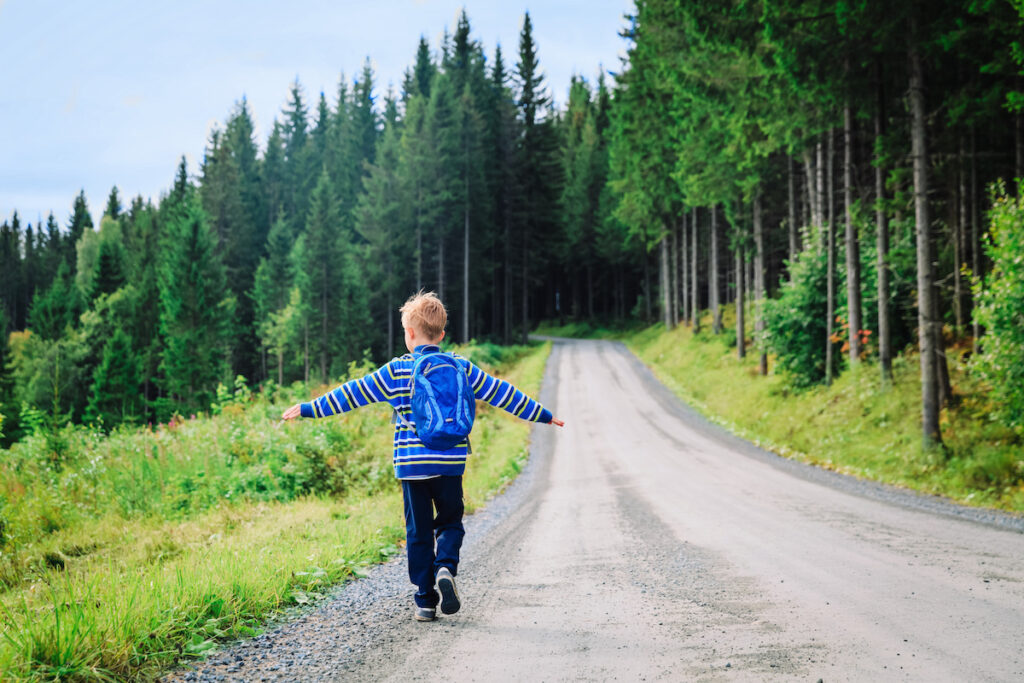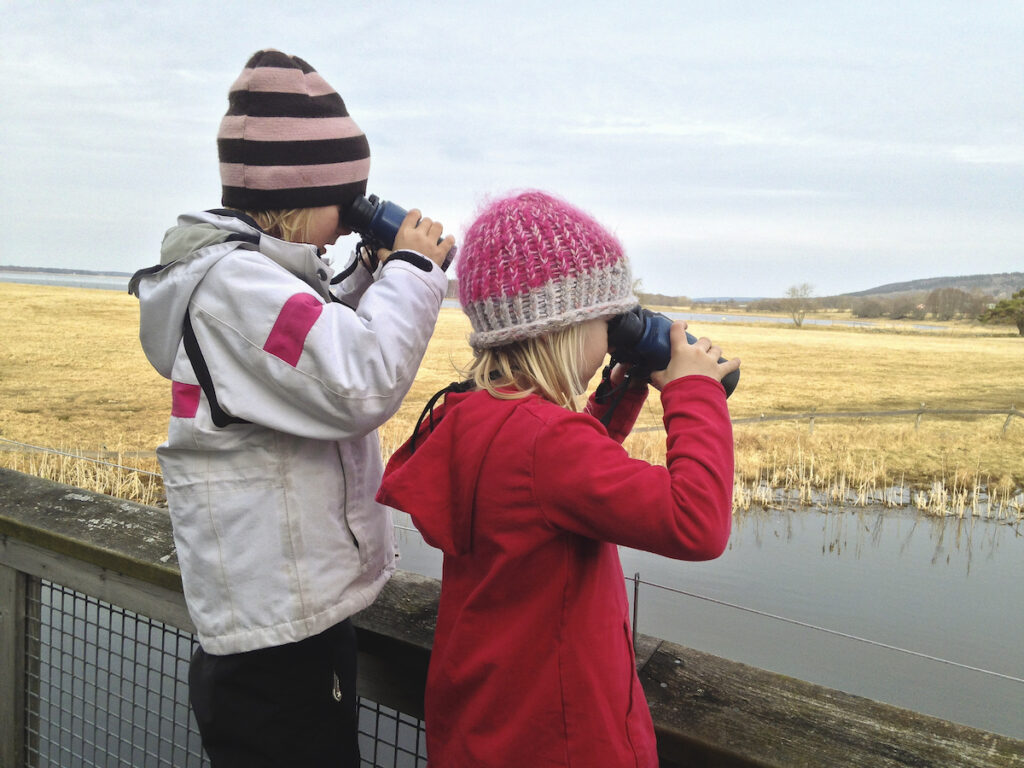Connecting Children with Nature Through the Nordic Art of Friluftsliv
Friluftsliv – also known as open air living – is the Norwegian idea that life is best lived outside. Learn about the benefits of friluftsliv and how this simple concept could be the perfect solution to the hectic modern lifestyle both for kids and adults.

When I was growing up, my parents wouldn’t have described our family as particularly outdoorsy. They never aspired to bag any big peaks, nor did we own much outdoor gear or travel to exotic locations.
Still, the outdoors was a constant presence in my life from the day I was born. As a baby I, napped outside in my stroller, all year round. At daycare and preschool, I played outside for hours every day. And as I got older, I would go for walks around the neighborhood with my mom or wander around in the woods behind our house with my cousins.
Come wintertime, we went ice skating on the lake nearby and rode our sleds at breakneck speeds down the steep, local sledding hill. And despite my parents downplaying their credentials as outdoor adventurers, we usually spent school holidays either in a camper or on skis, depending on the season.
But again, we weren’t that outdoorsy. We were just a typical Swedish family steeped in the Nordic tradition of friluftsliv, or “open-air life.”
What Does Friluftsliv Mean?
The word friluftsliv translates to “open-air-living”. The term was coined by famed poet and Norwegian playwright Henrik Ibsen back in the 1850s, as a reaction against urbanization and industrialization. By purposely spending time in nature for leisure, people tried to connect with a way of life that had been lost when they had left the village for the city.
At first, friluftsliv was a privilege for the economic and cultural elite, but over time it evolved into a lifestyle for everybody that revolves around experiencing nature in everyday life.
Today, The Swedish Environmental Protection Agency defines friluftsliv as “spending time outside in natural and cultural landscapes for personal wellness and to experience nature without pressure to achieve or compete.”
Coming Home to Nature
The Norwegian government contends that it’s about embracing nature and enjoying the outdoors as a way of life, a “possibility of recreation, rejuvenation and restoring balance among living things.” I like to think of it as coming home to nature.
Unlike many other forms of outdoor recreation, typical friluftsliv activities are nonmotorized, noncompetitive, and don’t require a lot of money or equipment. The most common way to practice friluftsliv is simply by going for a walk, but it can also encompass activities like hiking, camping, canoeing and kayaking, biking, foraging, swimming, birding and bush craft.
Often, friluftsliv is enjoyed as a family, to strengthen not only the bond with Mother Nature but also relationships with loved ones. More than a set of activities, friluftsliv is an ethos and lifestyle that is passed on from one generation to the next.
August Casson, an American who spent 15 years living and working in Norway, experienced the Nordic friluftsliv culture first-hand and was hooked. When the time came to move back to Springfield, Illinois, he decided to bring the open-air culture with him, and once he had children, he instilled the ethos in his family.
“People think that because it’s flat in Illinois, there’s nothing to do, but I can drive for thirty minutes and go hiking, paddleboarding, or riding on bike trails. I think there’s stuff to do everywhere,” Casson said. “Americans tend to think that bigger is always better, but it doesn’t have to be Norway or the Colorado mountains or the Michigan Upper Peninsula. It could just be going to a local lake and renting a canoe.”
Similar to the Danish concept of hygge, or the beauty of finding comfort indoors, friluftsliv is about finding comfort and happiness outdoors. And the physical wellbeing and mental health benefits of spending time in green spaces for adults and children alike are well documented with fresh evidence emerging on a near weekly basis.
Another benefit of friluftsliv is that it is believed to help children develop resilience, as nature offers plenty of challenges for a growing body and mind.
As I write in my book The Open Air Life: Discover the Nordic Art of Friluftsliv and Embrace Nature Every Day, friluftsliv is about “growing personally by pushing the boundaries of your comfort zone and not being deterred in the face of discomfort—mental or physical—in the outdoors. It’s about daring to try new things, taking pride in the effort, and feeling joy over the accomplishment.”
There’s Room for Every Child in Nature
At the same time, the noncompetitive, stress-free nature of friluftsliv makes it a prime way for families to connect in a society where life often seems to be a bit out of whack. If childhood has become a competitive race to excel in academics and sports, friluftsliv is the proverbial slow stroll in the park with plenty of time to stop and smell the dandelions.
“If you have kids, the focus is on them having fun,” said Linn Pollard, a mother of three from Stavanger, on Norway’s west coast. “You might take them on anything from short trips in the neighborhood to overnight camping trips. It has to be on their terms, or you’re not going to have a good time.”
Unlike sports and other activities that children tend to leave behind after high school, friluftsliv is a pastime that they will never outgrow – it will only evolve with age. For children who aren’t interested in sports to begin with, friluftsliv offers physical activity without the fear of not making the cut.
In nature, there is space for every child, regardless of ability. And if you can get a child hooked on friluftsliv early, it will be a powerful antidote to the allure of digital devices and the sedentary lifestyle that often results from excessive screentime.
Still, the most important contribution of friluftsliv may not be what it can do for us and our children, but the fact that it helps us develop an affinity for nature. Researchers believe direct experiences in nature, together with people who are close to them, will make children more passionate about protecting nature as adults.
Through friluftsliv, children come to understand that they are a part of the natural world and that it is for us to carefully maintain, not to exploit and destroy. Because what we do to the environment, we ultimately do to ourselves.
5 Ways to Start Living an Open-Air Life
The concept of friluftsliv originated in Northern Europe and is intimately connected with the Nordic culture, landscape, history, and mindset, but children’s need for nature is universal.

These are a few simple ways to start living an open-air life today, regardless of what part of the world you call home.
Adapt to the weather
Inclement weather is a common hurdle for getting outside and as adults we tend to focus on the potential discomfort and inconvenience. But it doesn’t have to be that way!
An important aspect of friluftsliv is to weatherproof your mindset and adapt your clothes, activity level and time outside according to the conditions at hand. By accepting the weather for what it is and not letting it get in the way of a good time, you help normalize outdoor play all year round.
Use the old Scandinavian saying “There’s no such thing as bad weather, only bad clothing” to help motivate yourself and your child, just keep in mind that it doesn’t apply to truly hazardous weather conditions.
Make the most of your nearby nature areas
Going on a trip to a pristine national park or remote locations can be awe-inspiring and generate memories for life, but these areas are not readily accessible to most people on a regular basis.
Fortunately, nature is everywhere, even in the city. Take advantage of your local green spaces and connect with the natural world in your own community. Remember that a local park or even a backyard can be a world of adventure to a young child.
When we live an open-air life, we hone our ability to observe nature in the little things, like the wind blowing in our hair, the clouds drifting slowly in the sky and the caterpillar making its way across the road.
Learn a new skill together
Many adults have fears and concerns about nature that prevent them from getting outside with their children. One way to ease those fears is to learn more about nature and how to meet your basic needs outside.
That doesn’t mean you have to be an expert naturalist to enjoy friluftsliv, just that having some basic knowledge of the eco systems that give us life will make you feel more in tune with nature.
There are any number of outdoor skills that can help you gain a deeper understanding of nature, for example birding, map reading, wild foraging, whittling, campfire building, and cooking outside. Find something simple about open-air living that interests you and run with it!
Take it slow
Children’s lives increasingly run on rigid schedules filled with organized activities and an ever-growing load of homework. Meanwhile, us adults have our own work, family responsibilities, and mental loads to deal with.
Friluftsliv is your invitation to ditch the agenda, unplug from your digital devices, and be in the present. Let your child be a child and explore nature without pressure to achieve or compete and trust that the learning is happening organically.
The slowest child sets the pace. Don’t stress if things don’t go as expected – sometimes playing at the trail head can be just as fun as going on a hike. If you get out the door, you’ve won.
Make nature part of your routine
In Norway, Sundays are reserved for the søndagstur, typically a longer outing on foot or skis that the whole family participates in, sometimes even grandparents. With no other distractions around, it’s easy for everybody to be heard and seen, and to connect with each other and the landscape.
Finding time to be outside might seem like a challenge, but the more packed your family’s schedule is, the more you stand to benefit from friluftsliv. If you can’t set aside a full day every week for an outing, try to get outside a little bit every day to make it a part of your family rhythm.
What does your family do to enjoy the open fresh air and encourage an outdoor lifestyle? Share in the comments.
